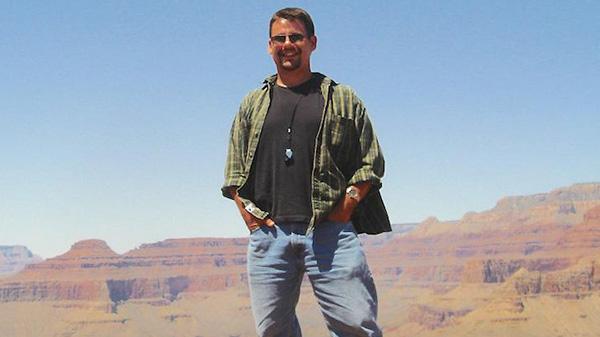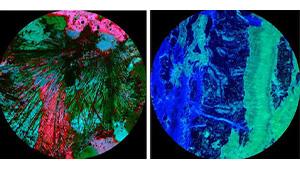Since earning his MS from the School of Earth and Space Exploration in 2012, Brad Vance has been bringing the mineral content and the textural relationships of rocks to life by creating spectacular petrographic photography of what geologists customarily study in thin sections.
According to Professor Stan Williams of SESE, “Brad has done very creative things with materials that geologists have studied for years but not with Brad’s perspective, curiosity, and true artistic capabilities”.
Most impressively, Dr. Williams notes, “he began the process working as a very earnest graduate student who stared at those thin sections for so long that he was able to produce a great improvement in our understanding of the McDowell Mountains.”
We were lucky enough to chat with Brad before his latest collection, titled, “Art of Rocks” debuted at the Tempe Center for the Arts as a part of the Science, Technology, Engineering, Arts, and Mathematics (STEAM) exhibit. Here’s what Brad had to say about his experience at SESE and his subsequent artistic endeavors in petrography:
SESE: What was your "aha" moment, when you realized you wanted to study the field you majored in?
Vance: I took an oceanography course at a community college in California, which spurred my interested in Earth’s processes. Once I discovered the math involved to obtain a degree in geology, I went with my second love: English Literature. I wouldn’t revisit geology until my late 20s, long after I had established a career in healthcare administration. But it always bothered me some that I didn’t go with my gut, so I returned to school to pursue degrees in geoscience.
SESE: What made you choose ASU?
Vance: I chose ASU because of their strong graduate studies in geology, that my favorite professor Stephen Reynolds agreed to mentor me, and the fact that I call Phoenix home.
SESE: Is there a particular faculty member at ASU who was influential?
Vance: I’ve had so many professors who contributed to my education in different ways. However, Professor Stanley Williams probably had the greatest impact on me. I worked for him as a teaching assistant for his Geological Disasters course, and from our first meeting, we hit it off famously. He was patient with me as I learned how to work with him, and with challenging students. We reconnected some years later and have done multiple projects and events together, and will continue to do so. He has been a major advocate for me and what I have been doing since starting my own business.
SESE: What advice do you have for students who may be following your path?
Vance: Start looking for opportunities to work with your professors on projects from the first day of class, early on in your educational career. Many professors have multiple research projects going on that they are more than happy to have help with. Such work looks great on a resume, will introduce you to research methods, and will serve you well should you decide to pursue graduate school.
SESE: What's something you learned while at ASU - in the classroom or otherwise - that surprised you, that changed your perspective?
Vance: The passion of both my peers and the professors for Earth science took me by surprise. It seemed as though everyone loved what they were doing, were thoroughly engaged, and galvanized to learn more. Such enthusiasm was catching, and helped me through both my undergraduate and graduate studies.
SESE: What was your favorite spot on campus, whether for studying, meeting friends or just thinking about life?
Vance: Behind F-Wing in the Bateman Science building is a quiet little hideaway that no one seemed to know about. I spent quite a bit of time studying there, or reading while in between classes. I periodically took a few power naps back there, I admit.
SESE: If someone gave you $40 million to solve one problem on our planet, what would you tackle?
Vance: Forty-million dollars alone wouldn’t solve any of our global or national issues certainly, but I feel it would make a tremendously solid start for a foundation to do even more over time. So many people suffer from hunger, disease, and lack of access to clean water. I would love to start a foundation with a similar model to that of the Bill and Melinda Gates Foundation, or the Clinton Foundation, that could address those issues associated with global poverty.
Note: “Art of Rocks” will continue to be on display at Tempe Center for the Arts until September 17, 2016.

